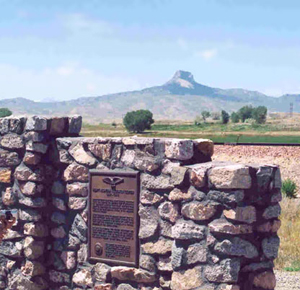
The poignant, long ago moment is captured in one of a huge collection of photographs from the Heart Mountain internment camp for Japanese-Americans that has been donated to Washington State University.
The black-and-white photos were taken by George Hirahara and his son Frank, who were among about 1,000 residents of the Yakima Valley who were incarcerated at the internment camp in Wyoming during World War II. They were donated by Patti Hirahara, Frank’s daughter, who wanted the historic images to be available to as many people as possible.
“It has spurred lots of inquiries from organizations who want access to the photos,” said Hirahara of Anaheim, Calif., about her donation. “I’ve got requests from families who wanted to see the photos to look for family members.”
Some of the photos were previewed this week at the campus library.
Hirahara, who was born after the war, said three generations of her family—her great grandfather, grandfather and father—were interned at Heart Mountain.
The approximately 2,000 black-and-white photos depict life in the camp between 1943 and 1945, and are said to be the largest collection of photos from Heart Mountain, which was located near Cody, Wyo. About half will be available online starting in October 2012, thanks to a $49,000 grant from the National Park Service.
Trevor Bond, head of WSU’s Manuscripts, Archives and Special Collections, said the photos are remarkable.
“The sharp quality of the images will allow researchers to examine minute details in the photographs, such as the food on the table or the crops grown in the Heart Mountain compound,” he said.
The forced removal of about 120,000 people of Japanese ancestry from the West Coast to inland camps is one of the shameful episodes of World War II. Nearly two-thirds of the people sent to camps were American citizens born in the United States.
Heart Mountain became a temporary home for more than 10,000 people from Washington, Oregon and California during the war.
The Hirahara family was housed in Barrack 15, and most of the photos were of activities around the barracks and of other internees from the Yakima Valley.
George Hirahara came to the United States at the age of 4, the only son of Motokichi and Sato Hirahara. His parents farmed in Wapato, and George grew up to be owner of the Pacific Hotel in Yakima, Wash. His only child was Frank.
All were sent to the camp in 1942. Frank attended Heart Mountain High School. Internees were allowed to have cameras starting in 1943, and father and son began taking pictures as a hobby. George built a darkroom.
Both Hiraharas had outgoing personalities, and other internees began asking them to take their portraits, in formal and casual settings, WSU said.
After the war, George returned to the Yakima Valley, taking the photos with him. He became a U.S. citizen in 1954.
Frank Hirahara went to Washington State University in Pullman, where he lettered in track and got a bachelor’s degree in electrical engineering in 1948. He worked for NASA in Southern California, where he worked on the Apollo, Skylab and space shuttle missions. He died in 2006.
Frank’s only child, Patti, discovered the photos in her grandparent’s attic in Yakima, in the early 1990s, and had them shipped to her home in Anaheim.
A journalist and public relations executive, Patti lent some of the photos over the years for displays at the Anaheim Public Library and a city museum.
She also donated items from her family’s Yakima roots to the Yakima Valley Museum for an on-going exhibit about Japanese pioneers in the valley. That exhibit will run through 2013.
But Patti still had the large collection of photos from the internment camp, and wanted to preserve it for future generations.
Because her father attended WSU, she contacted the school and arranged the donation earlier this year. Reaction was immediate after the gift was initially announced.
“We never expected this collection would draw this much attention,” she said.
She has been working with survivors of the camps and their families to identify the people in the photos.
“A network of survivors is helping me,” she said. “People want to make sure this story is told correctly.”
Copyright 2011 Associated Press. All rights reserved. This material may not be published, broadcast, rewritten, or redistributed.
AP-WF-09-17-11 2347GMT

